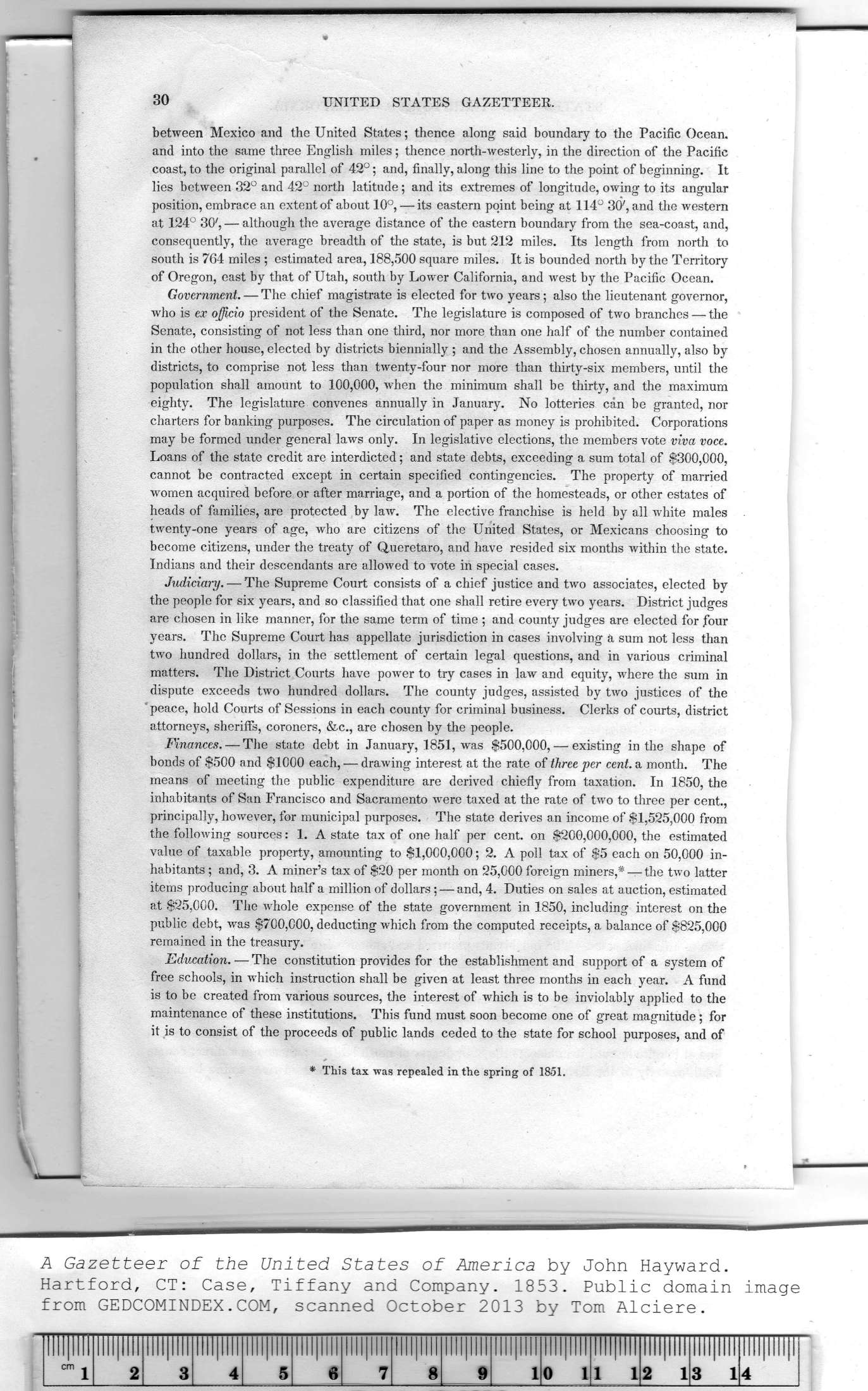|
|
Note: Ctrl and + increases the font size of the text below, Ctrl and - decreases it, and Ctrl and 0 resets it to default size.
30 UNITED STATES GAZETTEER.
between Mexico and the United States; thence along said boundary to the Pacific Ocean,
and into the same three English miles; thence north-westerly, in the direction of the Pacific
coast, to the original parallel of 42°; and, finally, along this line to the point of beginning. It
lies between 32° and 42° north latitude ; and its extremes of longitude, owing to its angular
position, embrace an extent of about 10°, — its eastern point being at 114° 30', and the western
at 124° 30', — although the average distance of the eastern boundary from the sea-coast, and,
consequently, the average breadth of the state, is but 212 miles. Its length from north to
south is 764 miles ; estimated area, 188,500 square miles. It is bounded north by the Territory
of Oregon, east by that of Utah, south by Lower California, and west by the Pacific Ocean.
Government. — The chief magistrate is elected for two years ; also the lieutenant governor,
who is ex officio president of the Senate. The legislature is composed of two branches — the
Senate, consisting of not less than one third, nor more than one half of the number contained
in the other house, elected by districts biennially ; and the Assembly, chosen annually, also by
districts, to comprise not less than twenty-four nor more than thirty-six members, until the
population shall amount to 100,000, when the minimum shall be thirty, and the maximum
eighty. The legislature convenes annually in January. No lotteries can be granted, nor
charters for banking purposes. The circulation of paper as money is prohibited. Corporations
may be formed under general laws only. In legislative elections, the members vote viva voce.
Loans of the state credit are interdicted; and state debts, exceeding a sum total of $300,000,
cannot be contracted except in certain specified contingencies. The property of married
women acquired before or after marriage, and a portion of the homesteads, or other estates of
heads of families, are protected by law. The elective franchise is held by all white males
twenty-one years of age, who are citizens of the United States, or Mexicans choosing to
become citizens, under the treaty of Qucretaro, and have resided six months within the state.
Indians and their descendants are allowed to vote in special cases.
Judiciary. — The Supreme Court consists of a chief justice and two associates, elected by
the people for six years, and so classified that one shall retire every two years. District judges
are chosen in like manner, for the same term of time ; and county judges are elected for four
years. The Supreme Court has appellate jurisdiction in cases involving a sum not less than
two hundred dollars, in the settlement of certain legal questions, and in various criminal
matters. The District Courts have power to try cases in law and equity, where the sum in
dispute exceeds two hundred dollars. The county judges, assisted by two justices of the
peace, hold Courts of Sessions in each county for criminal business. Clerks of courts, district
attorneys, sheriffs, coroners, &c., are chosen by the people.
Finances. — The state debt in January, 1851, was $500,000, — existing in the shape of
bonds of $500 and $1000 each, — drawing interest at the rate of three per cent, a month. The
means of meeting the public expenditure are derived chiefly from taxation. In 1850, the
inhabitants of San Francisco and Sacramento were taxed at the rate of two to three per cent.,
principally, however, for municipal purposes. The state derives an income of $1,525,000 from
the following sources: 1. A state tax of one half per cent, on $200,000,000, the estimated
value of taxable property, amounting to $1,000,000; 2. A poll tax of $5 each on 50,000 in-
habitants ; and, 3. A miner's tax of $20 per month on 25,000 foreign miners,* — the two latter
items producing about half a million of dollars; — and, 4. Duties on sales at auction, estimated
at $25,000. The whole expense of the state government in 1850, including interest on the
public debt, was $700,000, deducting which from the computed receipts, a balance of $825,000
remained in the treasury.
Education. — The constitution provides for the establishment and support of a system of
free schools, in which instruction shall be given at least three months in each year. A fund
is to be created from various sources, the interest of which is to be inviolably applied to the
maintenance of these institutions. This fund must soon become one of great magnitude ; for
it is to consist of the proceeds of public lands ceded to the state for school purposes, and of
* This tax was repealed in the spring of 1851.
|
lllllllll |
llll llll |
|
|
llll|llll |
lllllllll |
lllllllll |
lllllllll |
llll|llll |
lllllllll |
lllllllll |
lllllllll |
lllllllll |
lllllllll |
|
|
cm j |
2 |
3 |
4 |
5 |
6 |
7 |
8 |
9 |
1 |
0 1 |
1 1 |
2 1 |
3 1 |
4 |
|
